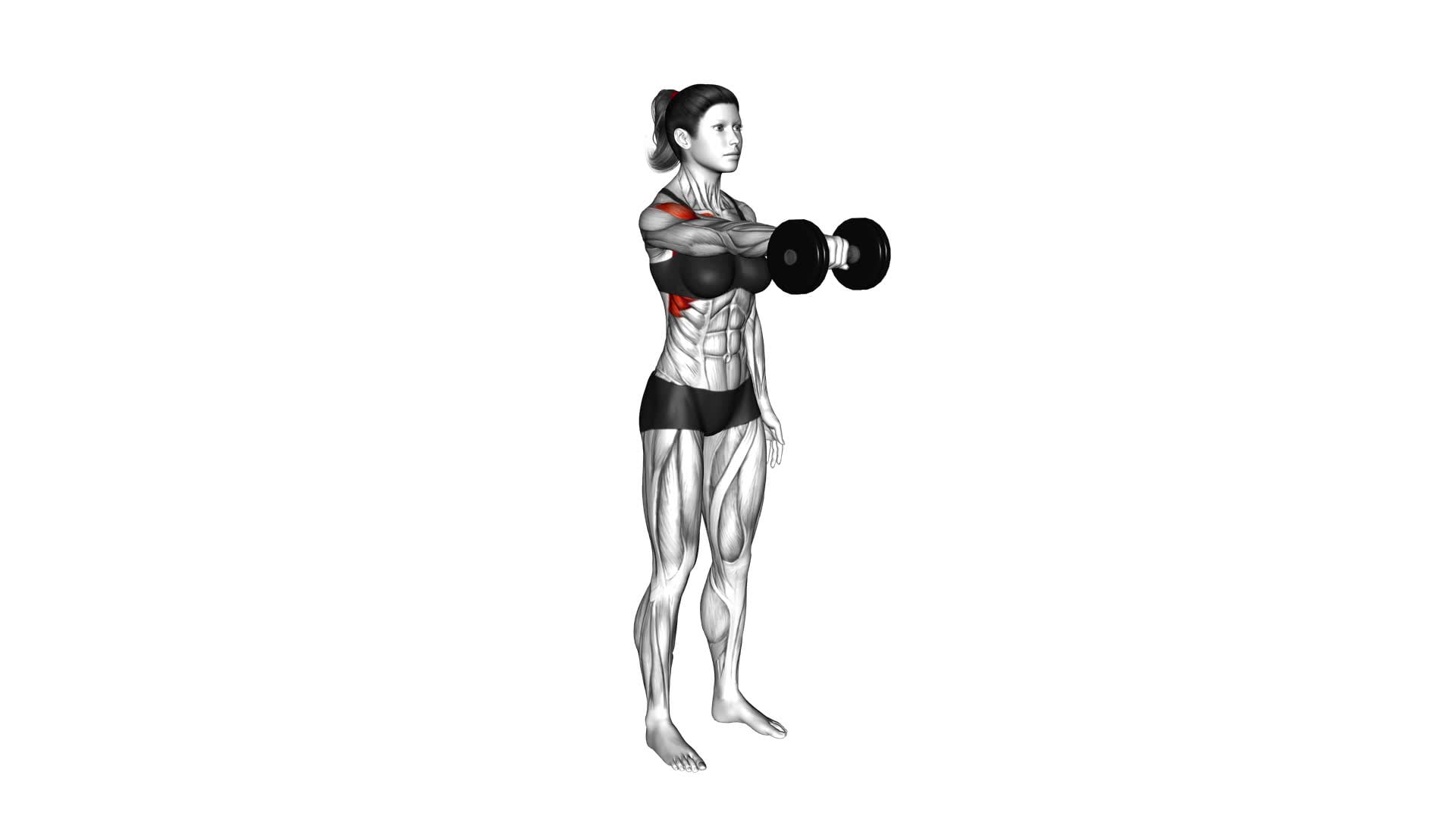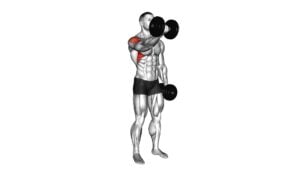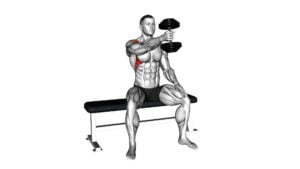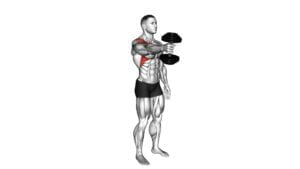Dumbbell One Arm Front Raise (female) – Video Exercise Guide & Tips

Are you looking to strengthen your upper body and sculpt your shoulders? Look no further than the dumbbell one arm front raise.
Watch This Exercise Video
This exercise targets your deltoids, providing you with toned and defined shoulders.
In this video exercise guide, we'll show you the proper form and technique, help you choose the right weight, and offer tips to avoid common mistakes.
Spice up your workout routine and incorporate the dumbbell one arm front raise today!
Key Takeaways
- Targets and strengthens the muscles in the shoulders, particularly the anterior deltoids
- Improves posture by engaging the muscles in the upper back and shoulders
- Enhances shoulder stability by targeting the muscles responsible for stabilizing the shoulders
- Reduces the risk of injury and enhances overall shoulder function
Benefits of Dumbbell One Arm Front Raise
Improve your shoulder strength and stability with the dumbbell one arm front raise. This exercise is highly effective for targeting and strengthening the muscles in your shoulders, particularly the anterior deltoids. By incorporating the dumbbell one arm front raise into your workout routine, you can experience several benefits that contribute to improving your overall posture and shoulder stability.
One of the key benefits of this exercise is its ability to improve posture. As you perform the dumbbell one arm front raise, you engage the muscles in your upper back and shoulders, which help to pull your shoulders back and improve your posture. By strengthening these muscles, you can reduce the likelihood of slouching and maintain a proper upright posture throughout the day.
Additionally, the dumbbell one arm front raise enhances shoulder stability. This exercise targets the muscles responsible for stabilizing your shoulders, such as the rotator cuff muscles. By strengthening these muscles, you can improve the stability of your shoulder joint, thereby reducing the risk of injury and enhancing your overall shoulder function.
To ensure you get the most out of the dumbbell one arm front raise, it's important to focus on proper form and technique.
Proper Form and Technique
To perform the dumbbell one arm front raise with proper form and technique, there are a few key points to keep in mind.
First, focus on maintaining proper body alignment by standing tall with your core engaged, shoulders relaxed, and feet hip-width apart.
Secondly, activate your shoulder and upper back muscles by initiating the movement from your shoulder joint and lifting the dumbbell directly in front of you, keeping your arm straight and avoiding any swinging or momentum.
Body Alignment Tips
How can you ensure proper body alignment during the dumbbell one arm front raise exercise?
Body alignment is of utmost importance in any exercise, as it helps to prevent injuries and maximize the effectiveness of the movement.
To maintain proper posture during the dumbbell one arm front raise, start by standing tall with your feet shoulder-width apart. Keep your core engaged and your back straight throughout the exercise.
As you raise the dumbbell in front of you, make sure to keep your shoulders down and relaxed, avoiding any shrugging or hunching. Additionally, maintain a slight bend in your elbow to avoid strain on your joints.
Muscle Activation Cues
To activate the correct muscles during the dumbbell one arm front raise exercise, focus on maintaining proper form and technique.
Start by standing with your feet shoulder-width apart and holding a dumbbell in one hand, with your palm facing your body. Keep your core engaged and your back straight throughout the exercise.
As you lift the dumbbell, exhale and raise your arm straight in front of you, stopping when it's parallel to the floor.
To ensure proper muscle activation, focus on using your shoulder muscles to lift the weight, rather than relying on momentum or swinging your arm.
If you find it difficult to maintain proper form, you can modify the exercise by using a lighter weight or performing the movement without any weights until you build up strength and control.
Remember to always listen to your body and consult with a fitness professional if you have any concerns or questions about exercise modifications.
Common Mistakes to Avoid
Avoid these common mistakes to ensure proper form and technique during the dumbbell one arm front raise exercise. Proper form is crucial for maximizing the benefits of this exercise and reducing the risk of injury.
One common mistake to avoid is using momentum to lift the dumbbell instead of relying on the strength of your shoulder muscles. This can lead to an ineffective workout and potential strain on your joints.
Another mistake is lifting the dumbbell too high, which can put unnecessary stress on your shoulder joint. Instead, focus on lifting the weight to shoulder level and maintaining control throughout the movement.
To spice up your workout, try variations such as using resistance bands or performing the exercise on an unstable surface like a BOSU ball. These variations challenge your stabilizing muscles and add variety to your routine.
Remember to start with a weight that's challenging but manageable, and always listen to your body to avoid overexertion.
Choosing the Right Weight
To effectively perform the Dumbbell One Arm Front Raise exercise, you should start by selecting a weight that's suitable for your fitness level and goals. The proper grip is crucial to maintain control and prevent injury during the exercise. Choose a weight that challenges you but allows you to maintain proper form throughout the movement. If the weight is too light, you won't be effectively targeting your shoulder muscles. On the other hand, if the weight is too heavy, you may compromise your form and increase the risk of injury.
Start with a weight that you can comfortably lift for 10 to 12 repetitions with proper technique. As you become stronger and more comfortable with the exercise, gradually increase the weight to continue challenging your muscles. It's important to increase the weight safely and gradually to avoid overexertion and strain. By selecting the right weight and gradually progressing, you can effectively build strength and improve shoulder stability.
Now that you know how to choose the right weight, let's move on to the next section and discuss common mistakes to avoid.
Common Mistakes to Avoid
When performing the dumbbell one arm front raise, it's important to avoid common mistakes that can hinder your progress and potentially lead to injury.
One common mistake to avoid is incorrect hand placement, such as gripping the weight too tightly or holding it too far in front of your body.
Another mistake to watch out for is rounding your back during the exercise, which can put unnecessary strain on your spine.
Lastly, using excessive momentum to lift the weight instead of relying on your muscles can diminish the effectiveness of the exercise.
Incorrect Hand Placement
Make sure your hand is positioned correctly for the dumbbell one arm front raise exercise. Proper hand placement is essential to ensure that you perform the exercise effectively and avoid potential injuries. To achieve the correct grip technique, start by holding the dumbbell with your palm facing your body. Place your hand around the handle, ensuring that your fingers wrap securely around it. Avoid gripping too tightly, as this can lead to unnecessary tension in your hand and wrist. Additionally, make sure that your thumb is positioned alongside your fingers, providing stability and control.
By following these hand placement tips, you can maximize the benefits of the dumbbell one arm front raise exercise and prevent any discomfort or strain.
Now, let's move on to the next section about rounding the back.
Rounding the Back
One common mistake to avoid when performing the dumbbell one arm front raise exercise is rounding the back. It's crucial to maintain proper posture throughout the movement to prevent unnecessary strain on the spine and potential injuries. To prevent rounding the back, engage your core muscles and keep your spine in a neutral position, imagining a straight line from the top of your head to your tailbone. By maintaining proper posture, you not only protect your spine but also maximize the effectiveness of the exercise.
Another common mistake to avoid is using excessive momentum. Using momentum to lift the dumbbell can reduce the effectiveness of the exercise and increase the risk of injury. Instead, focus on using your shoulder muscles to lift the weight in a controlled manner. This will help to target the intended muscles and ensure that you are getting the most out of the exercise.
Using Excessive Momentum
To avoid another common mistake, be mindful not to rely on excessive momentum while performing the dumbbell one arm front raise exercise. Using momentum instead of controlled muscle contraction can lead to various dangers and increase the risk of injury.
Here are some injury prevention tips to keep in mind:
- Maintain a slow and controlled movement throughout the exercise.
- Focus on engaging the targeted muscles, rather than relying on swinging the weight.
- Use a lighter weight if you find yourself relying on momentum too much.
- Keep your core and shoulder muscles stable and engaged to avoid excessive swinging.
- Concentrate on proper form and technique, ensuring that your shoulder stays in a safe and stable position.
Variations to Spice Up Your Workout
Try incorporating different variations into your workout routine to add some excitement and challenge. For advanced lifters, there are several variations that can be added to the dumbbell one arm front raise exercise.
One option is to perform the exercise while standing on a Bosu ball or a balance board. This will engage your core and challenge your stability, making the exercise more difficult.
Another variation is to perform the exercise using a resistance band instead of dumbbells. This will provide a different type of resistance and target your muscles in a unique way.
If you're a beginner, there are also modifications you can make to the dumbbell one arm front raise exercise.
One modification is to start with lighter weights or even no weights at all. Focus on mastering the form and technique before gradually increasing the weight.
Another modification is to perform the exercise with both arms at the same time. This will distribute the workload evenly and help you build strength before progressing to the single arm variation.
Incorporating different variations into your workout routine can help prevent boredom and plateauing. It challenges your muscles in different ways and keeps your workouts interesting.
Now, let's dive into how to incorporate the dumbbell one arm front raise into your routine.
Incorporating Dumbbell One Arm Front Raise Into Your Routine
To incorporate the dumbbell one arm front raise into your routine, start by selecting an appropriate weight and standing with your feet shoulder-width apart. This exercise is a great way to target your shoulder muscles and can be incorporated into your workout routine to add variety and challenge. Here are some tips for incorporating the dumbbell one arm front raise effectively:
- Begin with a light weight and gradually increase as you become more comfortable and stronger.
- Keep your core engaged and maintain good posture throughout the exercise.
- Start with a few sets of 8-12 repetitions on each arm, and gradually increase the number of sets as you progress.
- Alternate between arms to work both sides equally.
- Combine the dumbbell one arm front raise with other shoulder exercises to create a complete shoulder workout.
Incorporating dumbbell exercises like the one arm front raise into your routine not only helps to strengthen and tone your shoulder muscles, but also provides a great alternative to traditional shoulder workouts. By adding variety to your routine, you can prevent boredom and keep your workouts exciting and effective.
Frequently Asked Questions
How Many Sets and Repetitions Should I Do for the Dumbbell One Arm Front Raise?
To determine the number of sets and repetitions for the dumbbell one arm front raise, consider factors such as your fitness level and goals. This exercise primarily activates the shoulder muscles.
Start with 2-3 sets of 8-12 repetitions, focusing on proper form and controlled movements.
As you progress, you can increase the weight, sets, or repetitions. Remember, there are variations of this exercise that can target different areas of the shoulders for added variety and challenge.
Can I Perform the Dumbbell One Arm Front Raise With Both Arms at the Same Time?
Yes, you can perform the dumbbell one arm front raise with both arms at the same time. This variation is called the double arm front raise. It can be a great way to increase the intensity of the exercise and engage both shoulders simultaneously.
However, if you don't have access to dumbbells, you can also use other alternatives like resistance bands or water bottles filled with sand or water to perform the front raise.
Is It Necessary to Warm up Before Doing the Dumbbell One Arm Front Raise Exercise?
Before performing the dumbbell one-arm front raise exercise, it's necessary to warm up. Warming up helps prepare your muscles and joints for the workout, reducing the risk of injury. It increases blood flow, flexibility, and range of motion.
If you don't have dumbbells or prefer other exercises, there are alternatives to the front raise that target the same muscles, such as lateral raises or shoulder presses. Remember to always listen to your body and consult with a professional if needed.
Can I Use Resistance Bands Instead of Dumbbells for the One Arm Front Raise?
Yes, you can absolutely use resistance bands instead of dumbbells for the one arm front raise exercise. Resistance bands provide a different type of resistance compared to dumbbells, which can help improve strength and stability.
The benefits of using resistance bands include increased muscle activation, improved joint stability, and the ability to target specific muscle groups. So go ahead and give it a try, and see how resistance bands can enhance your workout routine.
Is It Safe to Do the Dumbbell One Arm Front Raise Exercise if I Have Shoulder or Neck Pain?
If you have shoulder or neck pain, it's important to prioritize your safety and comfort during exercise.
The dumbbell one arm front raise exercise can put strain on your shoulders and neck. It may be best to avoid this exercise until your pain subsides.
Instead, focus on exercises that promote shoulder mobility and consider modifications for shoulder pain, such as using lighter weights or resistance bands.
Consult with a healthcare professional for personalized guidance.
Conclusion
The dumbbell one arm front raise is a great exercise for targeting the front deltoids and improving shoulder strength. By using proper form and technique, choosing the right weight, and avoiding common mistakes, you can maximize the benefits of this exercise.
Additionally, incorporating variations of the dumbbell one arm front raise into your workout routine can keep things interesting and challenge your muscles in different ways.
So grab a dumbbell and start incorporating this exercise into your routine for stronger and more defined shoulders.

Author
Years ago, the spark of my life’s passion ignited in my mind the moment I stepped into the local gym for the first time. The inaugural bead of perspiration, the initial endeavor, the very first surge of endorphins, and a sense of pride that washed over me post-workout marked the beginning of my deep-seated interest in strength sports, fitness, and sports nutrition. This very curiosity blossomed rapidly into a profound fascination, propelling me to earn a Master’s degree in Physical Education from the Academy of Physical Education in Krakow, followed by a Sports Manager diploma from the Jagiellonian University. My journey of growth led me to gain more specialized qualifications, such as being a certified personal trainer with a focus on sports dietetics, a lifeguard, and an instructor for wellness and corrective gymnastics. Theoretical knowledge paired seamlessly with practical experience, reinforcing my belief that the transformation of individuals under my guidance was also a reflection of my personal growth. This belief holds true even today. Each day, I strive to push the boundaries and explore new realms. These realms gently elevate me to greater heights. The unique combination of passion for my field and the continuous quest for growth fuels my drive to break new ground.



